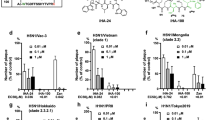Abstract
We examined the antiviral effects of three oligopeptides, carbobenzoxy (Z)-d-Phe-Ile-Gly, Z-d-Leu-Ile-Gly and Z-d-Phe-Phe-Gly, which mimic the N-terminal regions of F1 glycoproteins of two Newcastle disease virus strains (Miyadera and D26) and Sendai virus, respectively. Only one of these peptides, Z-d-Phe-Phe-Gly, significantly and with a similar potency inhibited viruses of homologous and heterologous F1 N-terminal sequences, suggesting no strict sequence requirement for inhibition. Furthermore, the enveloped RNA viruses of several different families showed essentially the same sensitivity to the three peptides as the paramyxoviruses, while a nonenveloped RNA virus was not susceptible to any of them. In addition, the Z-d-Phe-Phe-Gly peptides was effective only when the virus particles had been pretreated before infection.
Similar content being viewed by others
References
Abenes GH, Kida H, Yanagawa R (1986) Antigenic mapping and functional analysis of the F protein of Newcastle disease virus using monoclonal antibodies. Arch Virol 90:97–110
Asano K, Asano A (1988) Binding of cholesterol and inhibitory peptide derivatives with the fusogenic hydrophobic sequence of F-glycoprotein of HVJ (Sendai Virus): possible implication in the fusion reaction. Biochemistry 27:1321–1329
Asano K, Asano A (1989) Cholesterol binding and interaction mode of peptidic inhibitors with F-glycoprotein of HVJ (Sendai virus): implication in the fusion reaction. In: Compans RW (ed) Cell biology of virus entry, replication, and pathogenesis. Alan R. Liss New York, pp 187–196
Epand RM (1986) Virus replication inhibitory peptide inhibits the conversion of phospholipid bilayers to the hexagonal phase. Biosci Rep 6:647–653
Epand RM, Epand RF, McKenzie R (1987) Effects of viral chemotherapeutic agents on membrane properties. Studies of cyclosporin A, benzyloxycarbonyl-D-phe-L-phe-gly and amatadine. J Biol Chem 262:1526–1529
Fujino M, Kobayashi S, Ohbayashi M, Fukuda T, Shinagawa S, Nishimura O (1976) The use of N-hydroxy-5-norbornene-2,3-dicarboximide active esters in peptide synthesis. Chem Pharmaceut Bull (Tokyo) 22:1857–1863
Gething MJ, White JM, Waterfield MD (1978) Purification of the fusion protein of sendai virus: analysis of the NH2→NH2-terminal sequence generated during precursor activation. Proc Natl Acad Sci USA 75:2737–2740
Homma M, Ohuchi M (1973) Trypsin action on the growth of Sendai virus in tissue culture. III. Structural difference of Sendai viruses grown in eggs and tissue culture cells. J Virol 12:1457–1465
McCune JM, Rabin L, Feiberg M, Lieberman M, Kosek J, Reyes G, Weissman I (1988) Endoproteolytic cleavage of gp 160 is required for the activation of human immunodeficiency virus. Cell 53:55–67
Nagai Y, Klenk HD, Rott R (1976) Proteolytic cleavage of the viral glycoproteins and its significance for the virulence of Newcastle disease virus. Virology 72:497–508
Richardson CD, Scheid A, Choppin PW (1980) Specific inhibition of paramyxovirus and myxovirus replication by oligopeptides with amino acid sequences similar those at the N termini of the F or HA2 viral polypeptides. Virology 105:205–222
Richardson CD, Choppin PW (1983) Oligopeptides that specifically inhibit membrane fusion by paramyxovirus: studies on the site of action. Virology 131:518–532
Sato H, Oh-hira M, Ishida N, Imamura Y, Hattori S, Kawakita M (1987) Molecular cloning and nucleotide sequence of P, M, and F genes of Newcastle disease virus avirulent D26 strain. Virus Res 7:241–255
Scheid A, Choppin PW (1974) Identification of biological activities of paramyxovirus glycoproteins. Activation of cell fusion, hemolysis, and infectivity by proteolytic cleavage of an inactive precursor protein of Sendai virus. Virology 57:470–490
Scheid A, Choppin PW (1977) Two disulphide-linked polypeptide chains constitute active F protein of paramyxoviruses. Virology 80:54–66
Toyoda T, Sakaguchi T, Imai K, Inocencio NM, Gotoh B, Hamaguchi M, Nagai Y (1987) Structural comparison of the cleavage-activation site of the fusion glycoprotein between virulent and avirulent strains of Newcastle disease virus. Virology 158:242–247
Toyoda T, Gotoh B, Sakaguchi T, Kida H, Nagai Y (1988) Identification of amino acids relevant to three antigenic determinants on the fusion protein of Newcastle disease virus that are involved in fusion inhibition and neutralization. J Virol 62:4427–4430
Toyoda T, Sakaguchi T, Hirota H, Gotoh B, Kuma K, Miyata T, Nagai Y (1989) Newcastle disease virus evolution. II. Lack of gene recombination in generating virulent and avirulent strains. Virology 169:273–282
Varsanyi TM, Jornval H, Norrby E (1985) Isolation and characterization of the measles virus F1 polypeptide: comparison with other paramyxovirus fusion proteins. Virology 147:110–117
Author information
Authors and Affiliations
Rights and permissions
About this article
Cite this article
Inocencio, N.M., Gotoh, B., Toyoda, T. et al. Evaluation of the antiviral effect of synthetic oligopeptides whose sequences are derived from paramyxovirus F1 N termini. Med Microbiol Immunol 179, 87–94 (1990). https://doi.org/10.1007/BF00198529
Issue Date:
DOI: https://doi.org/10.1007/BF00198529




